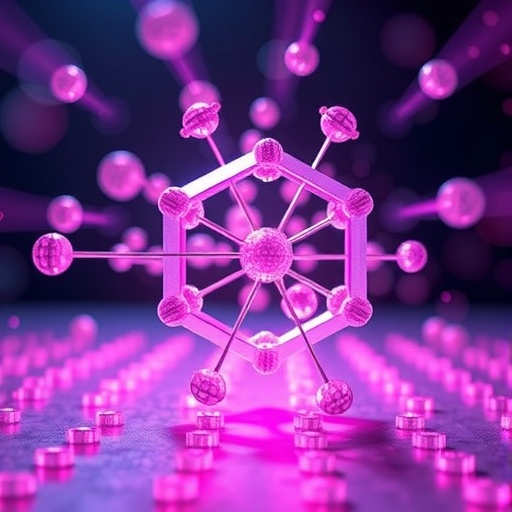In a groundbreaking advancement poised to reshape the landscape of quantum computing, researchers have unveiled a pioneering fault-tolerant quantum architecture utilizing neutral atoms. This innovative system harnesses reconfigurable arrays containing up to 448 neutral atoms to implement universal quantum computation with unprecedented error mitigation capabilities. As quantum computers race toward practical scalability, the critical challenge of ensuring fault tolerance—protecting quantum information from cumulative errors—has remained a formidable obstacle. This new work provides both a conceptual and experimental leap forward by integrating several sophisticated techniques that collectively enhance the reliability and efficiency of quantum error correction mechanisms.
Quantum error correction (QEC) is indispensable for building large-scale quantum computers capable of performing complex computations beyond classical capabilities. Yet, the intricacy of operating on encoded logical qubits—abstracted qubit states that protect information by distributing it across many physical qubits—presents profound engineering and conceptual challenges. The study under discussion offers a meticulous exploration of these challenges by experimentally implementing surface codes, a leading method for QEC, within an array of neutral atoms. Surface codes are particularly valued for their robustness, encoding quantum information on the two-dimensional lattice structure in a way that allows error detection and correction while minimizing resource requirements.
Leveraging the versatility of neutral atom platforms, the researchers conducted multiple rounds of quantum error correction in their experimental setup. Their key achievement was demonstrating a performance metric that exceeded the error threshold by a factor of approximately 2.14, a significant milestone indicating that error rates can be exponentially suppressed to enable fault-tolerant operations. This was accomplished through sophisticated atom loss detection methods and machine learning decoders, which interpret error syndromes and optimally correct them. By integrating adaptive algorithms with physical hardware, the system dynamically improves correction fidelity, marking a convergence of quantum hardware innovation and advanced classical computation.
The architecture also prioritizes the establishment of logical entanglement, necessary for complex quantum algorithms, by employing transversal gates and lattice surgery techniques. Transversal gates enable operations on encoded qubits without propagating errors across the entire logical state, maintaining fault tolerance. Meanwhile, lattice surgery provides a method of dynamically merging and splitting logical qubits, facilitating scalable quantum logic operations with minimized error overhead. Experimentally realizing these operations with neutral atoms is an extraordinary feat, showcasing the platform’s ability to execute layered quantum protocols required for universal quantum computation.
Building upon these foundations, the team extended their system’s capabilities using three-dimensional quantum error correction codes, specifically the [[15,1,3]] code, to employ transversal teleportation protocols. Such teleportation allows for the implementation of arbitrary-angle gate synthesis, transcending the discrete set of operations that often hinder quantum circuit efficiency. The approach uses polylogarithmic overhead, meaning the quantum resources required grow slowly relative to the complexity of the operations, an essential attribute for scaling. This advancement highlights how neutral atom arrays can embody complex, multi-qubit encoding schemes crucial for robust quantum logic.
Equally transformative is the development of mid-circuit qubit reuse, a technique that dramatically accelerates experimental cycle rates by approximately two orders of magnitude. This innovation allows qubits to be reset and recommitted within ongoing computations, enabling deep, multi-round circuits that involve dozens of logical qubits and hundreds of logical teleportations. Employing codes such as the [[7,1,3]] and high-rate [[16,6,4]], the architecture maintains constant internal entropy—a measure of information disorder or error—ensuring stable operation over extended computational sequences. Mid-circuit reuse represents a critical step toward practical fault-tolerant quantum processors where hardware efficiency and speed cannot be compromised.
The interplay of quantum logic gates and entropy removal forms the conceptual backbone of the architecture. By judiciously balancing physical entanglement through logic gates with magic state generation—a resource-intensive process crucial for universal quantum computation—the system maximizes operation fidelity and resource efficiency. Teleportation protocols further augment this balance by enabling universality and providing an effective physical qubit reset mechanism, serving as a bridge between error correction and logical gate implementation within the neutral atom platform.
This research not only demonstrates the feasibility of a scalable, universal, and fault-tolerant quantum computing architecture but also provides valuable insights into design principles that harmonize quantum information theory with experimental realities. The adaptability of neutral atoms, combined with their intrinsic potential for high-fidelity operations and connectivity, positions this platform as a front-runner for the next generation of quantum processors. Challenges such as error threshold management, qubit connectivity, and operational speed have been addressed with innovative solutions that integrate machine learning, 3D code architectures, and rapid qubit recycling.
The implications of these findings extend beyond mere proof-of-concept experiments. By establishing a robust framework for error correction and logical operations, this architecture moves closer to enabling practical applications in quantum simulation, cryptography, and complex computational problems that classical computers cannot solve efficiently. The integration of machine learning-based decoder strategies marks a paradigm where classical and quantum technologies synergize to push the frontier of computational power.
Moreover, the approach underscores the importance of modular and reconfigurable quantum hardware design. Neutral atom arrays can be dynamically reconfigured, allowing for real-time optimization of computational layouts and error correction strategies tailored to specific algorithms or operational conditions. Such versatility is a critical attribute for developing adaptable quantum processors capable of serving a broad spectrum of computational tasks while managing resource constraints effectively.
In conclusion, this pioneering work lays a robust foundation for the practical realization of scalable, fault-tolerant quantum computers using neutral atom technologies. By addressing the core challenges of error suppression, logical qubit manipulation, and operational speed with innovative methodologies, the researchers have forged a path forward that blends theoretical rigor with experimental precision. Their achievement signals a decisive step toward unlocking the vast computational potential promised by quantum mechanics, setting the stage for a new era of quantum information processing.
Subject of Research: Fault-tolerant architectures for universal quantum computation using neutral atom arrays.
Article Title: A fault-tolerant neutral-atom architecture for universal quantum computation.
Article References:
Bluvstein, D., Geim, A.A., Li, S.H. et al. A fault-tolerant neutral-atom architecture for universal quantum computation. Nature (2025). https://doi.org/10.1038/s41586-025-09848-5
Image Credits: AI Generated




